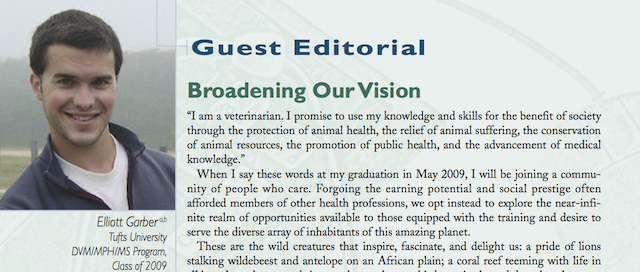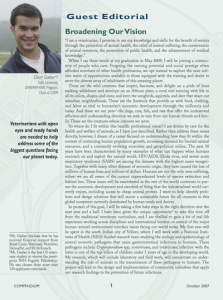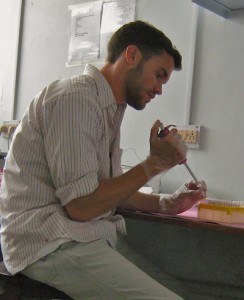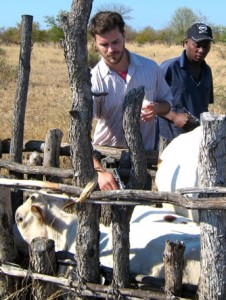Broadening Our Veterinary Vision: An Essay to Inspire

 It’s hard to believe that almost six years have passed since I wrote the following essay for Veterinary Compendium. The journal contacted me out of the blue several months after I found out that my applications for two different research training programs had been successful.
It’s hard to believe that almost six years have passed since I wrote the following essay for Veterinary Compendium. The journal contacted me out of the blue several months after I found out that my applications for two different research training programs had been successful.
They wanted to know if I would write something up about what I was planning to do for this uncommon year away from the normal veterinary curriculum. And they would pay me for my thoughts! That was the first money I ever earned for my writing.
I recently rediscovered the article buried in the recesses of my computer and was glad to see how little has changed in the dreams I have for my own career as a veterinarian. Sure, I’ve taken some detours, and my commitment to the Army hasn’t always allowed me to stay involved in some of the work that gets me most excited. But overall, I can trace a cohesive thread from that third-year veterinary student in 2007 to me as a grizzled old vet today.
So without further ado, here it is! You can also find the article on the Veterinary Compendium website, which requires free registration, or just download the PDF here.
Broadening Our Vision
“I am a veterinarian. I promise to use my knowledge and skills for the benefit of society through the protection of animal health, the relief of animal suffering, the conservation of animal resources, the promotion of public health, and the advancement of medical knowledge.”
When I say these words at my graduation in May 2009, I will be joining a community of people who care. Forgoing the earning potential and social prestige often afforded members of other health professions, we opt instead to explore the near-infinite realm of opportunities available to those equipped with the training and desire to serve the diverse array of inhabitants of this amazing planet.
These are the wild creatures that inspire, fascinate, and delight us: a pride of lions stalking wildebeest and antelope on an African plain; a coral reef teeming with life in all its colors, shapes, and sizes; and even the songbirds, squirrels, and deer that share our suburban neighborhoods. These are the livestock that provide us with food, clothing, and labor so vital to humanity’s economic development through the millennia and today. And these are our pets—the dogs, cats, fish, and rats that offer the undeserved affection and undemanding devotion we seek in vain from our human friends and family. These are the creatures whose interests we serve.
So where do I fit within this beatific professional vision? I am driven by care for the health and welfare of animals, as I have just described. Rather than address these issues directly, however, I dream of a career focused on understanding how they fit within the context of continuing human population growth, increasing demand for limited natural resources, and a constantly evolving economic and geopolitical milieu.
The past 50 years have been characterized by many examples of what can happen when humans encroach on and exploit the natural world: HIV/AIDS, Ebola virus, and severe acute respiratory syndrome (SARS) are among the diseases with the highest name recognition. Together with many other diseases of zoonotic origin, they have caused the loss of millions of human lives and trillions of dollars.
Humans are not the only ones suffering, either: we are all aware of the current unprecedented levels of species extinction and habitat loss. These issues will be exacerbated as the rest of the world continues to pursue the economic development and standard of living that the industrialized world currently enjoys, including access to cheap animal protein. I want to help identify problems and design solutions that will secure a sustainable future for all creatures in this global ecosystem currently dominated by human needs and desires.
In pursuit of this goal, I will be taking a few baby steps in the right direction over the next year and a half. I have been given the unique opportunityto take this time off from the traditional veterinary curriculum, and I am thrilled to gain a bit of real-life experience working across disciplines and international borders on several of the major human-animal-environment interface issues facing our world today.
My first year will be spent in the South Indian city of Vellore, where I will work with a National Institutes of Health (NIH)-funded research team studying the ecology and epidemiology of several zoonotic pathogens that cause gastrointestinal infections in humans. These pathogens include Cryptosporidium spp, noroviruses, and rotaviruses; infection with the latter is one of the top killers of children younger than 5 years of age in the developing world.
 My research, which will include laboratory and field work, will concentrate on understanding the role of animals in the transmission of these pathogens to humans. The project will lead to the design and implementation of community initiatives that apply our research findings to the prevention of future infections.
My research, which will include laboratory and field work, will concentrate on understanding the role of animals in the transmission of these pathogens to humans. The project will lead to the design and implementation of community initiatives that apply our research findings to the prevention of future infections.
My veterinary and public health training will enable me to contribute in several ways. The population-level “herd health” approach, although steadily losing ground in most veterinary schools around the country, still sets veterinarians apart from our physician counterparts. Curing individual patients will always be a central aspect of our role as health professionals; we cannot forget, however, that a holistic understanding of pathogens and the environments in which they exist is the only route to preventing these devastating clinical cases in the future.
Although the final goal of my research in India is to prevent human infections, a purely anthropocentric approach will never be successful in this endeavor. Only through a higher-level, multidisciplinary process capitalizing on the varied expertise of physicians, veterinarians, epidemiologists, microbiologists, and others can the critical points for intervention and prevention be identified.
The veterinary perspective is also important in helping prevent the vilification of animals involved in the transmission of these infections. There are too many examples of bats, dogs, and rats being demonized and persecuted as a result of research that identifies their role in zoonotic disease. Veterinarians involved in this work need to act as advocates for creatures that cannot speak for themselves. Rather than superficially blaming the animal that happens to be a reservoir or vector for a given pathogen, we can promote solutions that prevent the exposures and interactions crucial to transmission. I hope to do this for the livestock and wildlife I will be studying in India.
 Moving southwest across the Indian Ocean, I will spend the next 6 months working in Angola and Mozambique. This project, funded through the National Security Education Program, involves collaboration between the Wildlife Conservation Society and the International Rural Poultry Centre to implement village-based livestock development programs that seek to remove pressure from wildlife populations in surrounding conservation areas.
Moving southwest across the Indian Ocean, I will spend the next 6 months working in Angola and Mozambique. This project, funded through the National Security Education Program, involves collaboration between the Wildlife Conservation Society and the International Rural Poultry Centre to implement village-based livestock development programs that seek to remove pressure from wildlife populations in surrounding conservation areas.
Although the work will be quite different from that of the NIH with zoonotic diseases, it will also enable me to develop skills necessary to address important questions concerning the interaction of animals, humans, and the environment in this changing world. How can we protect these last wild areas on earth and the diversity of creatures they support while assisting their human inhabitants along the road to economic development? How do we promote local interest and initiative in protecting wildlife and other natural resources? My colleagues in answering these questions will be economists, aid workers, local villagers, and wildlife managers; as in India, the interdisciplinary nature will be vital to the project’s success.
And where do you fit in, as veterinary practitioners in the real world doing the good work of caring for and healing our fellow creatures, day in and day out? I hope that you will take a moment to think about why you first wanted to be a veterinarian—why you chose to be someone who cares. Could you take an afternoon, or even a day, away from the clinic to provide free services to a local shelter or perhaps conduct an educational program for area schools? How about a whole week mentoring students on a spay/neuter trip through the Humane Society’s Rural Area Veterinary Services program? I have had the opportunity to go on several such trips, and the guidance provided by clinicians like you has been invaluable in my professional development and in shaping my career goals.
Or what about something really radical, like applying for the federal government’s Fulbright Scholars Program or the Peace Corps? Many options are available for those who are ready for something different.
Veterinarians with open eyes and ready hands are needed to help address some of the biggest questions facing our planet today. So will you join me in embracing a broader and fuller vision of what it means to be a veterinarian? I look forward to that bright May day in 2009 when I will join your ranks and can say with confidence, “I am a veterinarian.”
———–
And now I am a veterinarian!
Looking for some more inspiration as you approach the academic year ahead or consider what the next step might be for you career-wise? Here’s another post that should get those wheels turning.
Are you ready to join the fun? Leave a comment to let us know what you’re doing to get there!

Comments
Your research sounds very interesting. As an inspiring wildlife veterinarian, with a degree in Wildlife Biology. I want to travel and do field work but how did you gain the opportunities to travel the way you do? I also have been considering a joint DVM and PHD program to pursue field research as well as veterinary medicine. How do you feel about these types of programs and would it benefit me with my research goals?
Kirsten, thanks for your comment and questions. I think that a joint DVM/PhD program would be a great way to go for someone like you who is interested in working with wildlife and traveling. These joint programs often have some type of stipend and/or tuition remission that makes the DVM degree significantly cheaper than it would be otherwise, so that’s a pretty good reason to consider it by itself. The thing you would need to be careful about is making sure that you would have flexibility in the PhD program to select your own research mentor and project — one that would enable you to do the traveling and field research that you want. Many of the PhD programs are much more focused on the strict laboratory side of the research.
The primary way that I got these opportunities to travel and do field work was by applying for a bunch of different research training programs/fellowships. I couldn’t have afforded to do it on my own, and I also would not have been able to set up the same high quality experience by myself. Good luck and stay in touch!
As a sophomore preveterinary student, I enjoyed this essay and it makes me excited for the type of work that I want to pursue in the future. I particularly liked the line, “Rather than address these issues directly, however, I dream of a career focused on understanding how they fit within the context of continuing human population growth, increasing demand for limited natural resources, and a constantly evolving economic and geopolitical milieu.” I find myself thinking about this a lot, as I am also interested in environmental conservation and how animals are going to be impacted in the future by humankind’s continuing population growth. As an army veterinarian, (as this is a path that I am strongly considering) did you find that there were there avenues within the military that allowed you to research the human impact on animal populations, or are these interests that you could only pursue outside of your military duties?
Good question, Emma. There are a lot of ways that I can try to tie in these broader interests during my work as a vet in the Army, but it’s true that it’s not my regular day-to-day job. Most of these opportunities are more in the realm of public health education about zoonotic diseases. Unfortunately I haven’t really found a way to get involved in conservation issues yet, but I know it’s possible. The Department of Defense is one of the biggest landowners in the U.S., so that means they are also responsible for a lot of wildlife. I know of one Army veterinarian, now retired, who did find a way to spend part of his career working more on the conservation and wildlife population medicine issues.
Dear Editor,We hope this message finds you well. We represent Hasni Surgical, and we have been a trusted name in manufacturing reusable medical devices.We are reaching out to propose a guest post contribution for your website. We recently came across your “Write for Us” page, and we believe a well-researched article on surgical instruments and wellness would align perfectly with your audience’s interests.The content will be 100% original, SEO-friendly, and tailored to your site’s tone and audience.Please let us know if their is any particular topic you would like us to write about. If this sounds interesting or if there are any specific guidelines I should follow, please let us know. We’d be happy to submit the draft for your review at your earliest convenience.Thank you for considering our proposal. We look forward to the possibility of collaborating with you.Best regards,
Hasni Surgical
hasnisales@gmail.com | https://hasnisurgical.com